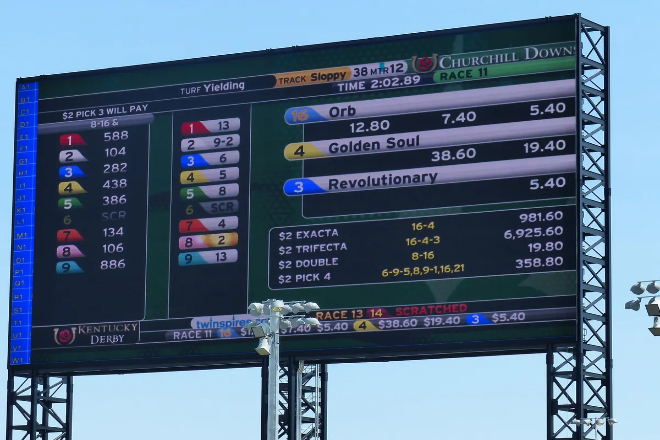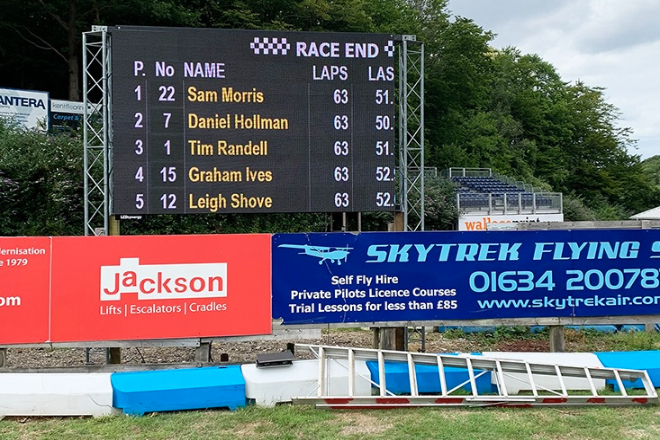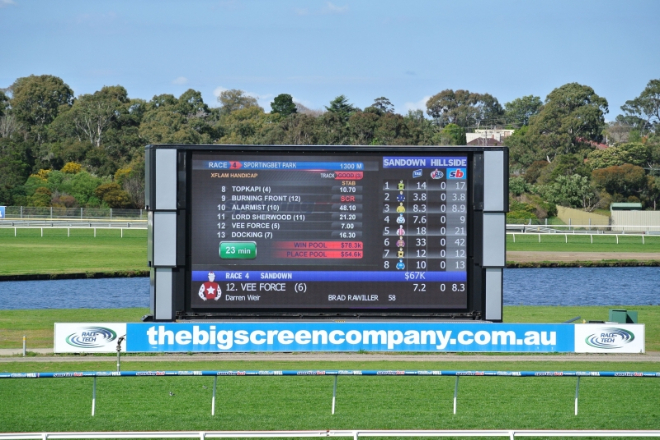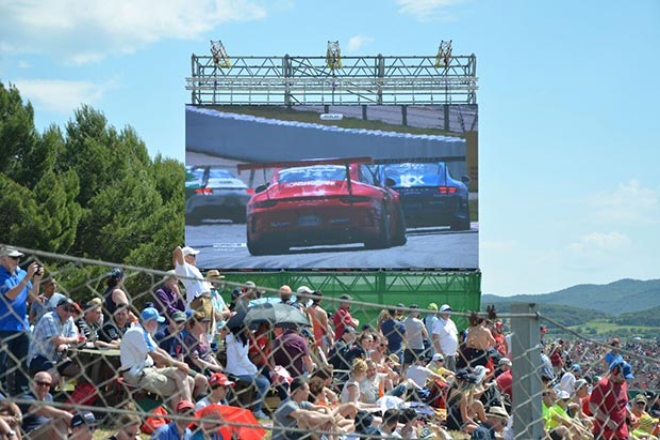序章
In the excitement of racing competitions, the audience not only pays attention to the speed on the track but also wants to know the ranking of drivers and the dynamics of the competition in real-time.
So, can LED表示画面 meet this demand? How can it improve the viewing and operational efficiency of the event? This article will reveal the answers to these questions for you.
目次
1. The current application status of LED display screens in racing competitions

1). Event information display
At the scene of the racing competition, the LED display screen is like the “eyes” of the audience, which can tell the audience various key information in real-time.
For example, which lap of the race is in progress, who is leading, whether there are any dangerous situations on the track, etc.
This information is very important to the audience, especially those who are not familiar with the rules of the game. They can easily keep up with the rhythm of the game through the LED display screen.
2). Advertising
LED display screens are also a “money-making tool” in racing competitions, and advertisers like it!
Because the competition site is crowded with people, the audience’s attention is highly concentrated, and the advertising effect is particularly good.
For example, in F1 races, the advertisements of big brands light up on the LED screen, and the audience can see them at a glance, which directly maximizes the brand exposure.
Moreover, the advertising content can be flexibly switched according to the progress of the game, such as showing different advertising content before the game, during the halftime break or at key moments so that the audience will not feel bored.
3)観客との交流
The LED display screen can not only display information and advertisements but also interact to make the audience more involved.
For example, before the game starts, the countdown can be played on the screen, and everyone counts down together, and the atmosphere rises immediately.
During the game, the audience voting results can also be displayed, such as “Which driver do you like most?” and “Who do you think will win.” The audience will be more excited when they see their voting results being displayed.
2. What are the benefits of LED display screens showing driver rankings in real time for event operations?

Imagine that you are sitting in the audience, staring at the track, thinking: “Hey, who is leading this lap?”
At this time, the real-time ranking of the drivers is suddenly displayed on the large LED screen, and you can instantly see who is speeding in front and who is chasing closely behind. This instant information is so useful!
The audience can see whether the driver they support is climbing up, and the feeling of tension and excitement is simply unstoppable.
In addition, when you see your favorite driver successfully overtake and move up one place in the ranking, the cheers can directly fill the atmosphere.
This real-time interaction makes the game no longer just a fun thing to watch. The audience can also follow the rhythm and cheer together, and the excitement of the game is doubled!
Event organizers also rely heavily on this real-time ranking function. It’s like you are directing traffic and suddenly find that there is a traffic jam on a certain road, and you have to deal with it immediately.
In a racing competition, when the organizer sees the driver ranking suddenly messed up on the LED screen, they know that something might have happened – either a crash or someone violated the rules.
They can react immediately, arrange rescue or adjust the rules of the competition to ensure that the competition can proceed smoothly.
Moreover, the staff can also prepare in advance. For example, if they see the driver is about to enter the maintenance area, the repair team can prepare tools in advance so that the driver can quickly repair the car and set off again.
In this way, the rhythm of the competition is smoother, there are fewer accidents, and the organizer’s work is much easier.
For sponsors, this real-time ranking function is simply a super billboard.
Think about it: when the audience is watching the game, their eyes will occasionally glance at the ranking on the big screen, and the sponsor’s advertisement is displayed together with the ranking information.
In this way, it is difficult for the audience not to see the advertisement!
Moreover, this advertising method is particularly smart because it perfectly integrates with the tense atmosphere of the competition.
Not only will the audience not be disgusted, but they will feel quite natural.
Sponsors are, of course, happy; their brand exposure has increased, and they are naturally more willing to pay to sponsor the competition.
For the event, this means more financial support, and the scale and influence of the competition can also be larger and larger.
The drivers themselves are also very concerned about this real-time ranking. When they are leading, they may think: “Hey, I have to keep steady and don’t make any mistakes.”
But if they see that they are behind, the feeling of unwillingness will directly inspire their fighting spirit and make them fight harder to overtake.
Moreover, drivers can also adjust their strategies according to the ranking.
For example, when they see that the driver in front is a little slower, they may think: “The opportunity is here. I can overtake him in this corner.”
Or, when they are leading, they may choose to be more conservative to ensure that they can cross the finish line smoothly.
This flexible adjustment not only allows drivers to better cope with the competition but also makes the competition more exciting and unpredictable.
The driver’s team can also provide better tactical support through real-time rankings.
Team members sitting in the maintenance area, looking at the rankings on the big screen, can know the situation of the drivers on the track.
They can tell the drivers when to speed up and when to pit for refueling according to the position of the opponents.
For example, if they see that the opponent is about to catch up, the team will remind the driver: “Pay attention, someone behind is about to overtake you, work harder!”
The staff in the maintenance area can also prepare in advance.
For example, if they see that the driver is about to hit, they can prepare tools and parts in advance so that the driver can quickly repair the car and set off again.
This efficient teamwork can make the driver more confident in the competition and improve the competitiveness of the entire team.
Finally, the real-time ranking display can also make the competition fairer and more transparent.
In past competitions, the audience and the drivers may have to rely on the referee’s verbal broadcast to know the situation, and sometimes, there will inevitably be disputes.
But now, the ranking is clearly displayed on the big screen, and it is clear who is leading and who is violating the rules.
The audience can see every detail of the game, and naturally, they will trust the fairness of the game more.
This transparent competition environment can not only reduce disputes but also greatly enhance the credibility of the event.
After all, everyone knows that the competition is fair and relies on strength, and no one will have any objections.
3. Operation steps for the LED display to display the driver ranking in real-time

1). Prepare the hardware equipment
First, you have to prepare all the equipment you need. Just like you have to prepare all the ingredients before cooking, you have to prepare three main things here:
- Event timing system:
This is the “brain” that records the driver’s performance. It can accurately know when each car crosses the line and how many laps it has run.
There are many brands on the market, such as Listen Sport, which is like the “Swiss watch” in the racing world and is accurate and reliable.
- LEDディスプレイ:
This is where the audience can see the ranking, just like the “face” of the game. You have to choose the kind you use outdoors, with high brightness, so you can see it clearly even in the sun.
And it must be waterproof and dustproof. After all, there is a lot of wind and sand on the track. If the screen accidentally gets sand, it will be troublesome.
- Network equipment:
This is the “courier” used to transmit data from the timing system to the display. You can use a wired network, like the network cable you have at home, which is stable and fast.
You can also use a wireless network, such as a 5G router, which is convenient and flexible, and you don’t have to worry about the cables tripping you.
2). Set up the timing system
Next, you have to install the timing system. Install the timing equipment at key locations on the track, such as the start, end, and timing points in the middle of the track.
These devices are like the “eyes” on the track and can accurately capture the time when the driver passes.
Then, enter the driver and vehicle information in the timing system, such as the driver’s name, vehicle number, and vehicle color.
You also have to set the rules of the race, such as how many laps the race will run and how long the track is. Only after this information is set up can the timing system know how to record the results.
Before the race starts, be sure to test it several times. Just like a rehearsal, see if the timing equipment can work properly and if there is any delay in data transmission.
If there is a problem with the timing system, there will be no way to talk about the ranking display later.
3). Connect the network
Network connection is the key to data transmission. Connect the timing system to the network.
If you use a wired network, make sure the network cable connection is stable and not loose.
If you use a wireless network, configure a 5G router to ensure that the signal coverage is wide enough, and the signal strength is strong enough.
Then, install the data processing software on the server. This software is like a “translator” that can translate the data sent by the timing system into a format suitable for the LED display.
Finally, don’t forget to test the network transmission. Just like testing whether the express delivery can be delivered on time, make sure that the timing system can transmit the data to the server in real time and that the server can receive the data normally.
If there is a problem in this step, the data cannot be updated in time, and the ranking seen by the audience will be delayed, affecting the viewing experience.
4). Set up the LED display
The installation and setting of the LED display are also critical. First, install the display in a location that is easy for the audience to see, such as next to the track or above the audience seats.
Just like hanging a billboard, every audience member must be able to clearly see the display content.
Then, connect the LED display to the network to ensure that it can receive the data sent by the server.
In the control system of the LED display, set the format of the display content.
For example, the font size should be moderate, the color should be eye-catching, and the scrolling speed should be appropriate. This will make the display content clear and easy to read.
After this step is set up, the audience can clearly see the ranking changes of the drivers during the game and be nervous and excited along with the rhythm of the game.
5). Data transmission and processing
Data transmission and processing are the core links of the entire system. The timing system will transmit the drivers’ real-time data, such as lap time, ranking, etc., to the server through the network.
The data processing software on the server will process the received data, extract the ranking information, and convert the data into a format suitable for display on the LED display.
Then, the server sends the processed ranking data to the LED display, and the display will update the display content in real-time. This process must be fast and accurate without delay.
Otherwise, the ranking seen by the audience will be inaccurate, affecting the viewing experience of the game.
Therefore, this step must ensure that the server performance is powerful enough, the data processing software is efficient enough, and the network transmission is stable enough.
6). Testing and debugging
Before the game officially starts, it is necessary to conduct sufficient testing and debugging.
You can organize a simulated race and let the drivers run a few laps according to the official race process to test the operation of the entire system.
Check whether the timing system can accurately record data, whether the server can process data normally, and whether the LED display can display the ranking in real-time.
If problems are found, such as data transmission delay, unclear display content, etc., timely adjustments and optimizations should be made.
For example, adjust the sensor position of the timing system, optimize the data processing algorithm of the server, or adjust the display format of the LED display.
This step is very important. Only through sufficient testing and debugging can we ensure that the system can run stably during the official competition and let the audience enjoy the wonderful competition.
7). Official competition
On the day of the official competition, start the entire system in advance. Before the start of the competition, ensure that the timing system and LED display are running normally and the data transmission channel is unobstructed.
During the competition, arrange special personnel to monitor the operation of the system and be ready to deal with possible problems at any time.
For example, if the timing system suddenly fails or the network connection is interrupted, the monitoring personnel can detect and take measures in time.
In this way, the audience can see the ranking changes of the drivers in real-time through the LED display, cheer together with the rhythm of the competition, and enjoy every wonderful moment of the competition.
4. Things to note when operating

1). Data Accuracy
Data is the core of the entire system. If the data is inaccurate, the rankings seen by the audience will be wrong and may even cause controversy.
So before the game, be sure to carefully calibrate the timing system and check whether the sensors are installed to ensure that they can accurately capture the time when the driver passes.
If the sensor position is inaccurate, the driver’s lap time may be misjudged. At the same time, several tests must be performed to ensure that the data can be accurately transmitted to the server and that the server can correctly process the data.
If the data is delayed or wrong, make adjustments in time. During the game, it is best to back up the data in real-time in case of system failure so that the data can be quickly restored to avoid affecting the game results.
2). Network stability
The network is the key to data transmission. If the network is unstable, the data transmission will be in a “traffic jam” or even interrupted.
This is a big problem because the rankings seen by the audience will be delayed or may not even be seen at all.
So, before the game, carefully check the network equipment to ensure that all connections are strong and reliable.
If it is a wireless network, make sure the signal strength is strong enough, and the coverage is wide enough.
It is best to prepare a backup network, such as a backup 5G router. If the main network fails, you can quickly switch to the backup network to ensure that the game is not affected.
During the game, arrange for someone to monitor the network status. If you find network delays or interruptions, you must quickly troubleshoot the problem.
For example, check whether the router is overheated or the network cable is loose. This ensures smooth data transmission during the game.
3). Audience experience
The audience is the protagonist of the game. Whether they can see clearly and happily is directly related to the success of the game.
Therefore, when setting up the LED display, you must consider the viewing angle and distance of the audience.
Install the LED display in a place where the audience can easily see it, such as next to the track or above the audience seats, to ensure that every audience can see the screen clearly and will not be blocked by other objects.
On the LED display, the font should be large, the color should be eye-catching, and the scrolling speed should be moderate.
For example, if the font is too small, the audience cannot see it clearly, and if the scrolling is too fast, the audience cannot keep up.
You can do a few more tests to see the audience’s feedback and then adjust to the best state. If the game is held outdoors, you must also consider issues such as direct sunlight and strong light reflection.
The angle or 輝度 of the screen can be adjusted to ensure that the audience can see clearly in any environment.
Only when the audience can see clearly and happily can the competition be truly successful.
When operating the LED display to display the driver rankings in real-time, you must pay attention to the accuracy of the data, the stability of the network, and the viewing experience of the audience.
Although these details seem small, they are actually very important. As long as these details are done well, the audience can enjoy a wonderful, smooth and fair racing competition!
5。結論
Through the introduction of this article, do you have a new understanding of the application of LED display screens in racing competitions?
From the real-time display of driver rankings to improving all aspects of event operations, LED display screens are becoming an indispensable assistant for racing competitions.
最後に、LEDディスプレイスクリーンについてさらに詳しく知りたい場合は、 ご連絡ください。
